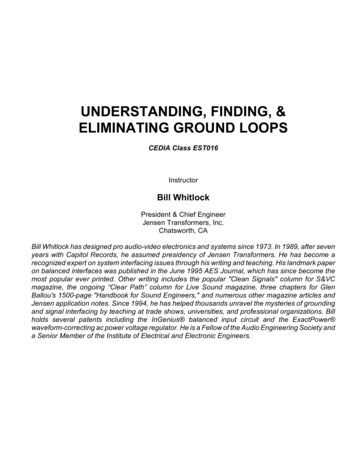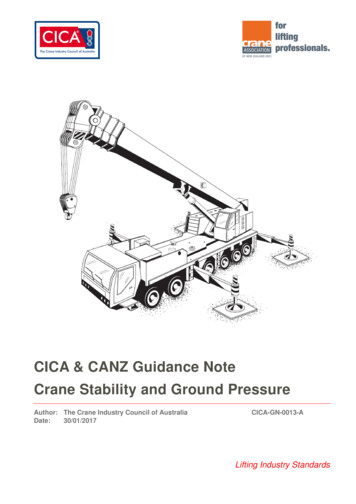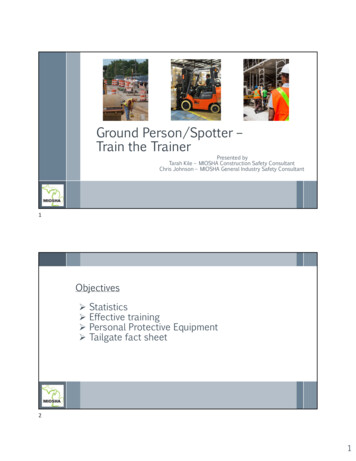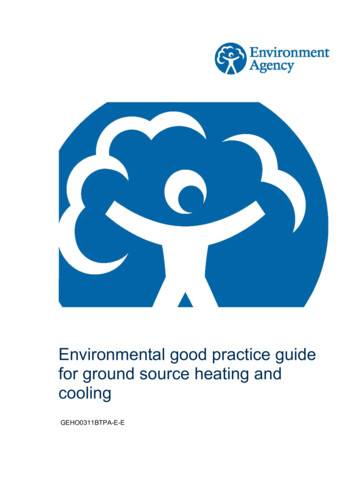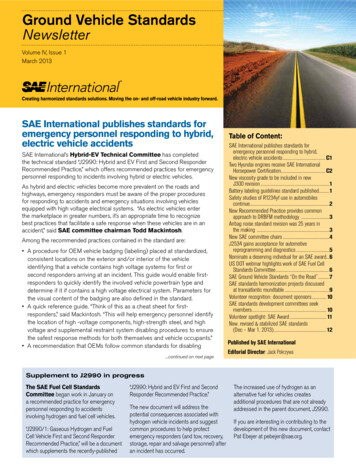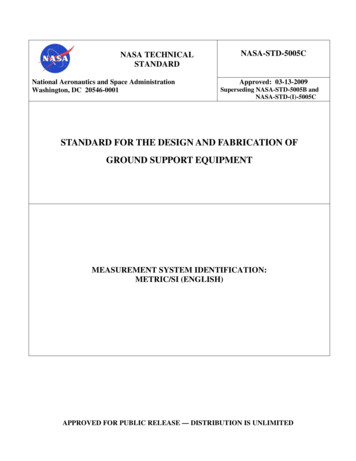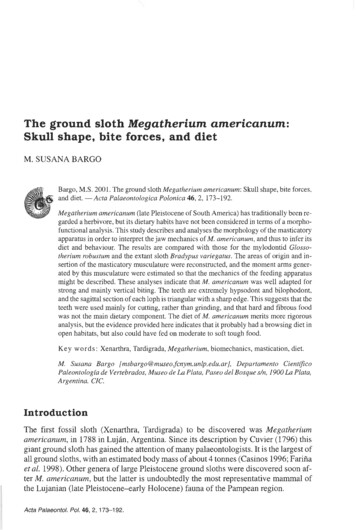
Transcription
The ground sloth Megatherium americanum:Skull shape, bite forces, and dietM. SUSANA BARGOBargo, M.S. 2001. The ground sloth Megatherium americanum: Skull shape, bite forces,and diet. -Acta Palaeontologica Polonica 46,2, 173-192.Megatherium americanum (late Pleistocene of South America) has traditionally been regarded a herbivore, but its dietary habits have not been considered in terms of a morphofunctional analysis. This study describes and analyses the morphology of the masticatoryapparatus in order to interpret the jaw mechanics of M. americanum, and thus to infer itsdiet and behaviour. The results are compared with those for the mylodontid Glossotherium robustum and the extant sloth Bradypus variegatus. The areas of origin and insertion of the masticatory musculature were reconstructed, and the moment arms generated by this musculature were estimated so that the mechanics of the feeding apparatusmight be described. These analyses indicate that M. americanum was well adapted forstrong and mainly vertical biting. The teeth are extremely hypsodont and bilophodont,and the sagittal section.of each loph is triangular with a sharp edge. This suggests that theteeth were used mainly for cutting, rather than grinding, and that hard and fibrous foodwas not the main dietary component. The diet of M. americanum merits more rigorousanalysis, but the evidence provided here indicates that it probably had a browsing diet inopen habitats, but also could have fed on moderate to soft tough food.Key words : Xenarthra, Tardigrada, Megatherium, biomechanics, mastication, diet.M. Susana Bargo [msbargo @museofcnym.unlp.edu.ar], Departamento CientljCicoPaleontologia de Vertebrados, Museo de La Plata, Paseo del Bosque s/n, 1900 La Plata,Argentina. CIC.Introduction1The first fossil sloth (Xenarthra, Tardigrada) to be discovered was Megatheriumamericanum, in 1788 in Lujiin, Argentina. Since its description by Cuvier (1796) thisgiant ground sloth has gained the attention of many palaeontologists. It is the largest ofall ground sloths, with an estimated body mass of about 4 tonnes (Casinos 1996; Farifiaet al. 1998). Other genera of large Pleistocene ground sloths were discovered soon after M. americanum, but the latter is undoubtedly the most representative mammal ofthe Lujanian (late Pleistocene-early Holocene) fauna of the Pampean region.1Acta Palaeontol. Pol. 46, 2 , 173-1 92.
174Diet of Megatherium: BARGOTraditionally, ground sloths were placed into three families, Megatheriidae, Mylodontidae, and Megalonychidae, which are considered to be monophyletic groups. TheNothrotherinae, including various Santacrucian genera (e,g., Hapalops, Eucholoeops,Pelecyodon) and the Plio-Pleistocene nothrotheres (e.g., Nothrotherium, Nothrotheriops) have been alternatively considered megatheriids or megalonychids. However, this assemblage has been recognized as paraphyletic. The Plio-Pleistocene taxaform a monophyletic group, for which familial distinction has recently been advanced(the Nothrotheriidae), while the Santacrucian 'nothrotheres' remain as successive outgroupgto the other ground sloths. Of the extant tree sloths, Bradypus apparently represents the sister-taxon to all other sloths, while Choloepus is a megalonychid (seeGaudin 1995, and references therein).For more than a century general speculations on the dietary preferences of groundsloths have been proposed, but without explanations of how the conclusions werereached. Essentially, they have always been considered herbivorous, primarily byanalogy with living tree sloths. Owen (1842, 1851) considered that giant sloths fed onthe foliage of trees. Stock (1925) stated that megatheres, together with megalonychidsand nothrotheres, were probably browsers, whereas mylodontids were grazers. Winge(1941: p. 364) noted that Megatherium 'has progressed farthest in specialisation as aplant feeder' and that it 'must undoubtedly have fed on unusually tough leaves whichrequired much power of mastication.' However, the great variation in skull and dentalmorphology, body size and proportion among ground sloths suggests that they had diversified to fill a variety of niches.The marked differences in the skeletal and dental anatomy of ground sloths andother mammalian herbivores, and the lack of recent analogues, makes it difficult to interpret the ecology of ground sloths, particularly of their dietary habits. Even the extanttree sloths are too specialised to provide good models. They are small mammals (lessthan 10 kilograms) that spend much of their lives suspended from the branches of treesand are barely able to travel on the ground (Mendel 1985).In a detailed analysis of the dietary preferences and ecology of the Plio-Pleistocenescelidotheres, McDonald (1987) suggested that these ground sloths were probably se-,lective feeders (according to Guthrie's 1984 classification), because the narrow anterior part of the skull was best suited for the selective harvesting of plant parts. Naples'(1987, 1989) studies of the masticatory apparatus of the North American slothsNothrotheriops shastense and Glossotherium harlani concluded that the former was aselective browser and the latter a browser-grazer, rather than a strict grazer. McDonald(1995) hypothesized that Megalonyx and Eremotherium were browsers. The dietaryhabits of Megatherium americanum, however, have not been considered in terms of adetailed morpho-functional analysis of its masticatory apparatus.This study describes and analyses the morphology of the masticatory apparatus ofM. americanum in order to interpret jaw mechanics and to infer diet and ecology. Theresults are compared with those for the mylodontid Glossotherium robustum and theextant Bradypus variegatus, as Naples (1982,1985,1989) has already considered various aspects of the masticatory apparatus for these genera. Further, the comparison isinteresting from the phylogenetical perspective because Glossotherium is considered aplesiomorphic taxon within the mylodontids (Perea 1992,1998) and Bradypus the sister-taxon to all other sloths (Gaudin 1995).
ACTA PALAEONTOLOGICA POLONICA (46) (2)175Abbreviations.-MLP, Museo de La Plata, Argentina; MACN, Museo Argentino deCiencias Naturales, Buenos Aires, Argentina; MPEG, Museu Paraense Ernilio Goeldi,BeEm, Brasil; FMNH, Field Museum of Natural History, Chicago, USA; RFTRA, Resistant Fit Theta-Rho Analysis; m., musculus.MaterialMegatherium american umMLP 2-64, skull and mandible,with part of the hyoid apparatus. Pampean Formation, Argentina. Figured in Lydekker (1894: pl. 45: 1)MLP 2-56, complete mandible. Pampean Formation. Argentina. Figured in Lydekker (1894: pl. 45:la).MACN 1000, nearly complete mounted skeleton. Rio Salado, Buenos Aires Province, Argentina.Megatherium gallardoiMACN 5002 (TYPE), skull and mandible, femur, humerus and ulna. Palermo, Buenos Aires, Argentina. Figured in Ameghino and Kraglievich (192 1).Megatherium sp.Museo Universitario C. y F. Ameghino, No. 899, nearly complete skull and complete mandible of ajuvenile; fragments of postskeleton and caudal vertebrae. Rio Carcarafiti, La Casilda, Santa FeProvince, Argentina.Glossotheriurn robustumMLP 3-137, skull, mandible, and part of the skeleton. Pampean Formation, Olivera, Buenos AiresProvince, Argentina.MLP 3-138, skull, mandible, and skeleton. Pampean Formation, San Antonio de Areco, Buenos Aires Province, Argentina. Figured in Lydekker (1894: pl. 5 l).MLP 3-140, skull, mandible, and skeleton. Pampean Formation, Olivera (Rio Lujtin), Buenos AiresProvince, Argentina. Figured in Lydekker (1894: pls. 49, 50: 1, and 52: 1).Bradypus variegatusMPEG 21809, skull and mandible. Parque Zoobotinico do Museu Paraense Ernilio Goeldi, BelCm,Brazil.MethodsVarious studies on extant mammals have demonstrated the correlation between dietand form of the skull, jaws, dentition and musculature (Maynard Smith & Savage1959; Turnbull 1970; Moore 1981; Smith 1993; Janis 1995). Such studies have beenuseful in the reconstruction of the masticatory musculature of fossil mammals and provide a framework for the analysis of diet and behaviour in edentates (Naples 1987,1989; Vizcaino 1994; Vizcaino & Farifia 1997; Vizcaino & Bargo 1998; Vizcaino et al.1998; De Iuliis et al. 2000).The masticatory muscles of Megatherium were reconstructed in order to estimate themoment arms of their lines of action, with the craniomandibular joint as pivot. Theocclusal patterns and mandibular movements were determined through study of thecraniomandibularjoint, the form and arrangement of the dentition, including occlusal
Diet of Megatherium: BARGOFig. 1.Skull (A) and mandible (B)of Megatherium americanum (MLP 2-64) in lateral view. Scale bar 10cm.wear patterns, and the form and structure of the mandibular symphysis. Morphometricanalyses were performed to evaluate differences with Glossotheriurn robusturn andBradypus variegatus.Masticatory musculature. - The estimation of the moment arms requires an interpretation of the form and position of the masticatory musculature. The areas of originand insertion of the muscles were reconstructed based on features of the skull and mandible (Turnbull 1976; Finch 1982; De Iuliis 1988), following the patterns of musculature in modem mammals (Maynard Smith & Savage 1959; Turnbull 1970), particularly those in the tree sloths B. variegatus and Choloepus (Sicher 1944; Naples 1985).The attachment sites of the muscles are indicated by features such as muscular scarlines, ridges, and crests. These suggest the attachment of aponeuroses and tendons; thetexture of the attachment surfaces indicate fleshy or tendinous origins and insertions.In extinct mammals the position of the muscles is often reasonably clear due to thepresence of these features. However, knowledge of the muscular arrangement in thenearest living relatives is essential. The musculature reconstructed for this analysis in-
ACTA PALAEONTOLOGICA POLONICA (46) (2)177Fig. 2. Skull of Megatherium americanumin dorsal (A)and ventral (B)views (MLP 2-64). Scale bar 10 cm.cludes the 3 jaw-closing muscles groups: temporalis, massetericus and pterygoideus(Turnbull 1970).Moment arms. - The moment arms of the lines of action of the temporalis andmassetericus muscles were estimated so that the mechanics of the masticatory apparatus of M. americanum could be described and compared with those of G. robustum andB. variegatus. The total lengths of the mandibles were standardised to allow comparison among forms of different sizes. A method proposed by Vizcaino et al. (1998) wasused, which allows comparisons between fossil and extant mammals. For the massetericus the lines of action were estimated from the most anterior and posterior positionsof the origin and insertion. For the temporalis, they were estimated from the most anterior, middle, and most posterior origins on the skull, and from a single insertion on thecoronoid process. In this way average values for the moment arms were obtained independently of the line of action of the muscle. Interpretations on the relationships between bite force and velocity may be made by comparing the proportions of the com-
178Diet of Megatherium: BARGObined moment arms of the massetericus and temporalis to those of different tooth positions (i.e., the anteriormost, middle, and posteriormost teeth).Shape analysis. - The shapes of the skull and mandible were analysed using amorphometric procedure that allows the determination of patterns of morphologicalvariability and change. This technique, Resistant Fit Theta-Rho Analysis (RFTRA),analyses changes in shape through the superimposition of one form onto another (baseand target specimens respectively) using the position of landmarks (homologous andgeometrical points). RFTRA identifies and measures the homologous regions ofchange in shape by establishing congruence among those that have not changed(Benson et al. 1982; for detailed information see Chapman 1990a, b, and referencestherein). Although RFTRA has been applied especially to identify shape variability ina taxonomical context, it has also been demonstrated as useful in morpho-functionalinterpretations (Chapman 1990b; Vizcaino & Bargo 1998; Vizcaino et al. 1998). Theskull and lower jaw of M. americanum were compared in lateral view with those ofGlossotherium robustum and Bradypus variegatus (as the base specimens).ResultsCranial morphologyExtensive descriptions of the skull and mandible of Megatherium americanum weregiven by Owen (1856), Lydekker (1894), Ameghino & Kraglievich (1921) and DeIuliis (1996). This section deals with the description of those features of the craniumthat are relevant for analysis of the mechanics of the masticatory apparatus.Skull.-The skull shape of M. americanum differs strongly from that of other Pleistocene ground sloths (Figs. 1 and 2). Its general form is approximately cylindrical, butthe cranial and rostra1 regions are narrow. This feature contrasts notably with the slender and elongated skull of Scelidotherium (Scelidotheriinae) or the prismatic-rectangular and anteriorly widened skull of Glossotherium robustum (Mylodontinae, Fig. 3).The premaxillae are stout, elongated and quadrangular, although the shape andlength vary considerably in different specimens (De Iuliis 1996). They became fusedfirmly to each other and the maxillae with age, and are thus often preserved with theskull. In G. robustum and Bradypus variegatus the premaxillae are arrowhead-shapedand loosely fused to the maxillae. This contributes to the frequent loss of these bones inthese taxa, as well as in most fossil sloths.In lateral view, the maxilla of M. americanum is approximately trapezoidal, and thealveolar or ventral margin is nearly straight. The edentulous part from MI to themaxillo-premaxillary suture varies notably in length.The zygomatic arch of M. americanum is large and robust (Fig. 1). The jugal consists of an approximately quadrangular body with five processes. The ascending anddescending processes are well d
Skull shape, bite forces, and diet M. SUSANA BARGO Bargo, M.S. 2001. The ground sloth Megatherium americanum: Skull shape, bite forces, and diet. - Acta Palaeontologica Polonica 46,2, 173-192. Megatherium americanum (late Pleistocene of South America) has traditionally been re-

